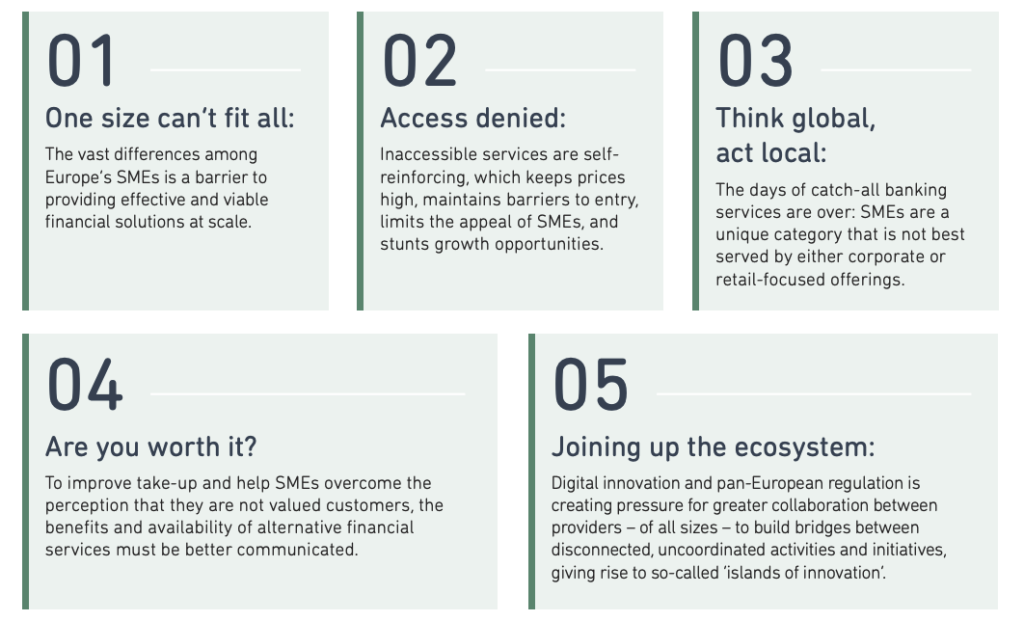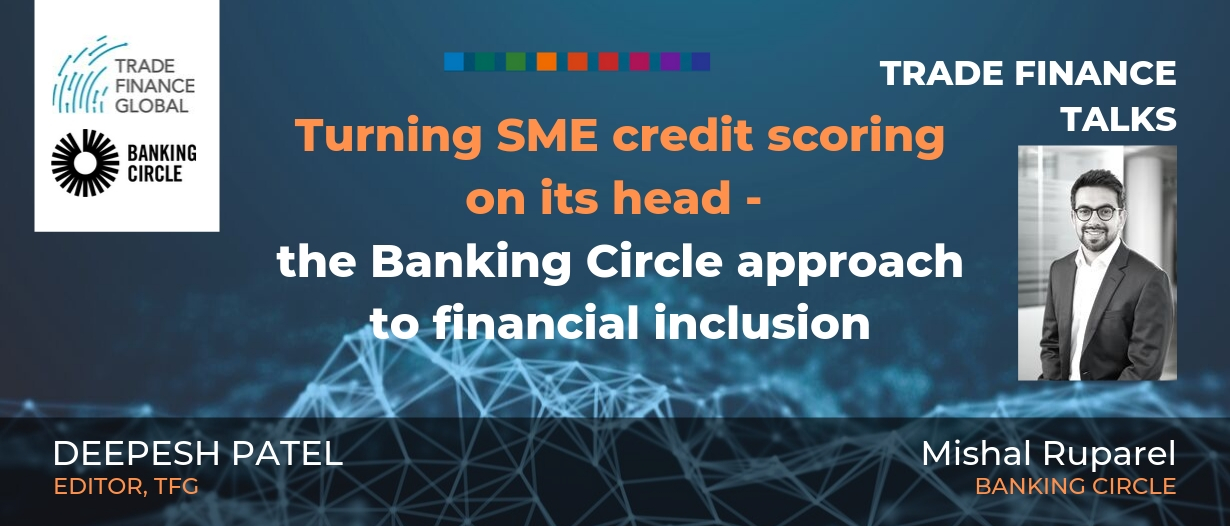Listen to this podcast on Spotify, Apple Podcasts, Podbean, Podtail, ListenNotes, TuneIn, PodChaser
Season 1, Episode 25
Host: Deepesh Patel, Editor, Trade Finance Global
Featuring: Mishal Ruparel, General Manager, Europe, Banking Circle

TFG spoke to Mishal Ruparel, General Manager at Banking Circle, about the new applications of technology in banking to help better serve the underbanked SMEs. Using AI-driven credit scoring and new approaches to analyse credit card transaction data, Banking Circle’s proposition is game-changing the world of SME finance.
Deepesh Patel: I’m Deepesh Patel, Editor at Trade Finance Global. Today, we’re live from SIBOS in London, and I’m joined by Mishal Ruparel, General Manager at Banking Circle. Mish, thank you very much for joining us here today.
Mishal Ruparel: Hi, Deepesh. Good to see you. And thanks for having me.
DP: Could you give me a quick introduction? Who are you, tell us a little bit about Banking Circle and also what you are here at SIBOS for?
MR: So Banking Circle is a provider of banking services to FinTechs and banks. We’ve been around just over five years, we were born through Saxo Bank, and recently acquired by Equity last year. So our clients are typically FinTech looking for core banking services. So services include: payments, accounts, foreign exchange and lending. At SIBOS, we’re really here to start launching into the bank space. So we have a international cash management solution, specifically targeted towards banks, and providing corresponding banking services.
DP: Great, thank you. So let’s start with lending and something obviously, us here at TFG, are very passionate and cover quite a lot about: SME, financial inclusion is a challenge and not just in the emerging markets, but even in the developed market. And something that’s been talked about quite a lot here at SIBOS. So what are the key pain points from an SME customer perspective? And why are we seeing it as such a big problem today?
The SMEs Are Heavily Excluded from the Financial Ecosystem

MR: SMEs are heavily excluded from the financial ecosystem. We ran a research paper quite recently, where we interviewed 500, SMEs, and I think some of the findings are pretty alarming.
50% of SMEs claim that they couldn’t get a loan, and when they could get a loan, it didn’t fit with their business model. They need a more tailored solution, they have to wait in excess of 60 days, and I was told that actually pretty optimistic to get a bank loan. And working capital for an SME is key. I mean, that’s just the lifeblood of their business. And a lot of these SMEs have seasonal businesses where they really need a tailored solution that really meets their requirements, you know, their business model.
At Banking Circle, we’re building solutions specifically focused on helping the space, you know, it’s not just on the lending side, but also on the payment side as well. And I’m happy to talk about that in greater detail. If that’s something you wanna hear about.
DP: Yes, absolutely. It’d be good to find out a little bit more about the technology because I guess, technology is potentially something that can help bridge the SME finance gap. And I guess I’m very keen to find out more about that due diligence and risk management in terms of assessing the viability of an SME accessing bank or non-bank finance.
How the Technology could Bridge the SME Finance Gap

MR: So I mean, some headline numbers there 24 million SMEs in Europe, you know, there’s something like four and a half million SMEs in the UK. And by 2025, there’s an expectation that they’ll contribute 240 billion pounds to the UK economy. So this is a large segment of the financial ecosystem. When we address working capital, there’s a real challenge over there. That’s allowing SMEs to access to get a loan. A lot of these SMEs you know, restaurants, hairdressers, gyms, they’re viewed as high-risk businesses to banks. And we don’t see it that way.
We’ve developed a lending solution, where our clients can provide loans to their corporates. So just to be clear Banking Circle is a Service Centre providing banking services to fin techs and bank so we don’t go after corporates directly, but we provide our clients solutions, which they can, in turn, help serve their corporate lending being one of the solutions. Many PSP and acquirers that are using our service, you know, acquiring is a very commodity space, you know, they’re fighting with basis points. So this is a really good addition to their products because they already own that customer relationship.
Now, what we do is we provide everything with the front end, the technology, the platform, even the capital associated with that loan, we will provide the full end to end service to that FinTech. I hate using the term turnkey solution. But that is really it is really what it is, it’s the full end to end solution. And then again, depending on the client, we can tailor the solution, and then they can, in turn, provide loan to the underlying merchants.
The decision making is Swift, it’s either instant or depending on the quality of the data (on a one-day basis). Within 24 hours we can provide a loan to that underlying merchant, they will receive the funds within 24 hours into their account. So it’s very quick as opposed to having to wait 60 to 80 days, which seems to be the average in the UK. And the way in which we assess the risk is we replace a lot of emphasis on card data. Soon as I talk about businesses like restaurants, and hairdressers, and gyms, a lot of these businesses are accepting credit cards, or debit cards as a method of payment. So we can see that historical data, which allows us to assess them better if that corporate is is eligible for a loan.
AI-driven Credit Scoring and New Approaches to Analyse Credit Card Transaction Data

DP: Great, thank you. So tell me a little bit more about that credit cards, oh, the payment processing data, because I imagine you probably collected huge wealth of data. And you’re then able to intelligently make decisions on whether that business deserves a certain amount of credit.
MR: There are a lot of data points we look at when assessing if a corporate is qualified for one of our loans. Card data plays a big part in that, it allows us to see the trends in how the business is performing. So you know, one of the ways in which we allow businesses to repay on their loan is a percentage of their turnover. Now we can do that. And I think that’s again, very tailored to an SME, the challenge a lot of SMEs have is if they go to a bank and they apply for a loan, they have a fixed payment they need to pay every single month. Now, if you are a seasonal business, that’s very challenging to try and keep with that fixed payment type structure. So as soon as their lending solution is not tailored for their particular business, what we can do is we can allow the business to pay a percentage of their turnover. So when the business is busy, they’ll pay more; when it’s quiet, they’ll pay less. We’re really building an interesting profile on that particular SME, that allows us to tailor the solution specifically to their business requirements.
DP: That’s interesting. And actually, I don’t think we’ve seen that kind of customer-first wave of solving a problem, and I think is really important because, yes, sometimes businesses do have huge seasonality and payment programmes tend to be the same month on month. So SIBOS, is there any exciting news coming out of Banking Circle right now or coming up soon?
MR: Yes. So firstly, I think it’s super exciting to be here. I think the scale is, is unbelievable. There are so many organisations here. So it’s been really exciting. For us, we are launching our international cash management solution. So this is really to aid banks that want to access local clearing in the UK and Eurozone. So it’s our big launch at SIBOS and it’s really to start is really to kick start our course one in banking solutions. That’s going to be a big part of our business going forward. You know, it’s been really, really exciting. I think the reception has been great. We’ve had a lot of meetings, the scans been really busy.
DP: So yeah, no, all good so far. Great. Well, we look forward to hearing more about this and seeing how the product develops over time. So I’m sure we’ll be in touch soon. Thank you very much for joining us.
MR: Thank you very much and have a good day.

































